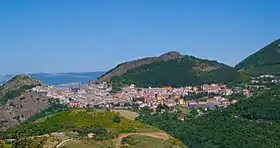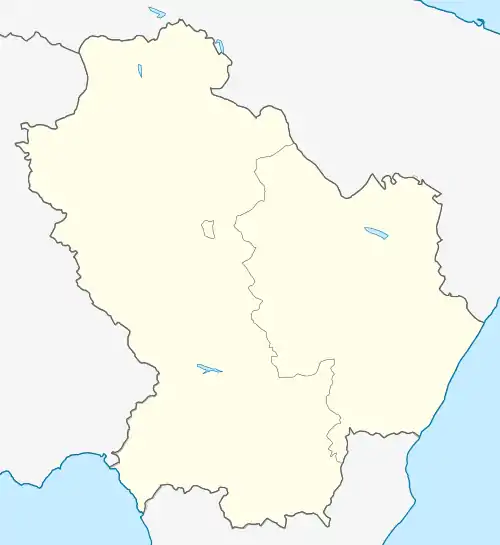San Fele
Sandə Fèlə | |
|---|---|
| Comune di San Fele | |
 | |
 Coat of arms | |
Location of San Fele | |
 San Fele Location of San Fele in Italy  San Fele San Fele (Basilicata) | |
| Coordinates: 40°49′N 15°32′E / 40.817°N 15.533°E | |
| Country | Italy |
| Region | Basilicata |
| Province | Potenza (PZ) |
| Frazioni | Agrifoglio, Armatieri, Difesa, Cecci, Montagna, Pierno, Priore, Masone, Signorella, Cerrito |
| Government | |
| • Mayor | Donato Sperduto |
| Area | |
| • Total | 97.7 km2 (37.7 sq mi) |
| Elevation | 872 m (2,861 ft) |
| Population (30 November 2015)[2] | |
| • Total | 3,002 |
| • Density | 31/km2 (80/sq mi) |
| Demonym | Sanfelesi |
| Time zone | UTC+1 (CET) |
| • Summer (DST) | UTC+2 (CEST) |
| Postal code | 85020 |
| Dialing code | 0976 |
| Patron saint | Saint Justin de Jacobis and Saint Sebastian |
| Saint day | 30 July and 20 January |
| Website | Official website |
San Fele (Neapolitan: Sandə Fèlə) is a town and comune in the province of Potenza in the Basilicata region of southern Italy.
Geography
San Fele is a picturesque stone village located at the saddle between two mountain peaks, Monte Toretta and Monte Castello, and overlooking the Vitalba Valley. The comune (municipality) of San Fele is part of the Comunità montana del Vulture, which makes it a gateway to the Vulture section of the province of Potenza in the state of Basilicata, Italy, which is famous for its excellent and economical aglianico wines. San Fele is also the trailhead for hikes to lovely waterfalls. The municipality of San Fele includes the towns of Atella, Bella, Castelgrande, Filiano, Muro Lucano, Rapone and Ruvo del Monte. San Fele also includes the hamlets of Agrifoglio, Armatieri, Cecci, Cerrito, Difesa, Montagna, Pierno, Priore, Masone, Signorella. It is also a short drive from Melfi and Melfi Castle. San Fele is about thirty-five miles east of Salerno, and is about a two hour drive from Naples or four hours from Rome.
History
Inhabited since ancient times by woodsmen and called Lucania by the ancient Greeks and Romans, the actual city of San Fele originated in 969, with the construction of an octagonal fortified castle on what is now called Monte Castello, commissioned by Otto I of Saxony to repel potential attacks by the Byzantines who ruled Southern Italy at the time. The area was seen as strategically important because the Crocelle Pass, the southern passage through the Apennine Mountains lies in the northeast corner of the Comune (municipality) of San Fele. From ancient times this Pass functioned as a major trade route between Salerno in the West and Bari in the East, both major trading ports. The route was also a major pathway for Crusaders and Pilgrims to the "Holy Land".
San Fele was named by the workers who built the fortress, and were from Venosa, an ancient Roman city also in Basilicata. They dedicated the fortress to their protector-saint, Saint Felix (San Felice), which has been shortened to Fele.
In the aftermath of the unification of Italy during the 1840s, much of the local population was displaced, and the area was affected by banditry. Famous brigands included Giovanni Fortunato, known as "Coppa", Vito Di Gianni, called "Totaro" and Francesco Fasanella, called "Tinna", who were part of the infamous Carmine Crocco. A television miniseries about these infamous highway bandits, Il generale dei briganti, was made in 2012.
As a result of this upheaval, and partly due to drought, deforestation and a devastating earthquake, San Fele was part of the large emigration of the late 19th century (to North and South America). A large number emigrated to the United States, including New York City, Buffalo, New York and Newark, New Jersey, Canada, Brazil and Argentina. In addition, after the upheaval of World War II, and particularly in the 1950s and '60s, many San Felese emigrated (to Argentina, Australia, Brazil, Germany, Switzerland, and northern Italy). Currently, the population of San Fele is about 3,000 people, down from over 10,000 in the 1870s.
The primary industry in San Fele is agriculture, and the area features lovely woodlands and hiking trails, and is known for the fertility of its volcanic soil which produces the excellent aglianico wines for which Basilicata is known, as well as mushrooms, truffles, cheese, game, and handmade pasta. Although much of the area was deforested due to a timber boom during the 19th century and to clear land for farming, part of the Comune of San Fele includes a national park with lush forestland dominated by oak, maple, beech and mountain pine. Because San Fele is located at a higher altitude, this is a restful place to escape the heat of summer and to see pristine nature, including San Fele's small and charming waterfalls or "cascade".[3]
San Fele feast days include: January 20: Feast of the Patron Saint Sebastian 1st Sunday of May: Feast of the Madonna di Pierno 30 July: Feast of San Giustino de Jacobis 15 August: Feast of the Madonna of Pierno 8 September: Feast of the Madonna of Pierno
San Fele hosts the Basilicata International Film Festival in August, and the Feast of Madonna di Pierno, which has been celebrated since 1139 AD, also in August. San Fele is also known as the birthplace of San Giustino de Jacobis (on 9 October 1800), whose home has been restored and is now a destination for pilgrims.
Many descendants of San Felese diaspora have created San Fele Societies, including the San Felese Society of New Jersey, the San Fele Association of Western New York, and San Felesi in Australia.
Famous residents
- Beniamino Bufano (1890–1970), Italian American sculptor
Twin towns
 Muro Lucano, Italy, since April 6, 2010
Muro Lucano, Italy, since April 6, 2010 Bologna, Italy, since 1981
Bologna, Italy, since 1981.svg.png.webp) Drummoyne, Sydney, New South Wales, Australia, since 1985
Drummoyne, Sydney, New South Wales, Australia, since 1985
References
- ↑ "Superficie di Comuni Province e Regioni italiane al 9 ottobre 2011". Italian National Institute of Statistics. Retrieved 16 March 2019.
- ↑ "Popolazione Residente al 1° Gennaio 2018". Italian National Institute of Statistics. Retrieved 16 March 2019.
- ↑ "San Fele Waterfalls in the Lucan Apennines - Basilicata".
External links
- Official website

- San Felese Society of New Jersey
- San Fele Association of Western New York
- San Felesi in Australia
- San Fele Genealogy site